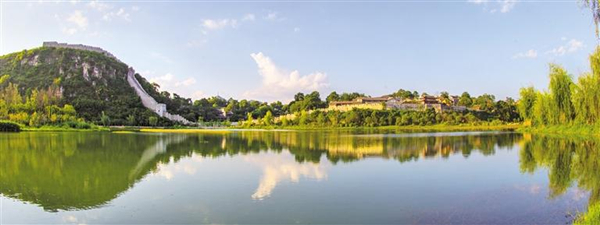Huaxi sees huge socioeconomic progress over past 5 yrs

Qingyan Ancient Town in Huaixi district [Photo/Guizhou Daily]
Huaxi district in Guiyang, capital of Southwest China's Guizhou province, achieved its goal in promoting socioeconomic development and building a well-off society over the past five years.
During the period, the gross domestic product of Huaxi exceeded 70 billion yuan ($10.53 billion), while the industrial added value above designated size, investment in fixed assets, and total retail sales of consumer goods increased 8.2 percent, 8.7 percent, and 6.9 percent on average per year, respectively.
Optimization of industrial structure
A modern industrial system dominated by electronic information and specialty food industries has taken shape in Huaxi.
Several enterprises in the district were selected as provincial professional, innovative and competitive enterprises with strong growth potential in specific industries.
The output value of high-tech enterprises accounted for more than 30 percent of the total industrial output value of enterprises above designated size – those with annual revenue of 20 million yuan or more.
A logistics model relying on Gaimao Modern Logistics Park, Shiban Dili Agricultural Products Logistics Park, and Transfar Intelligent Highway Port was also formed, and number of mid-to-high-end commercial complexes began operating smoothly.
The number of market entities in the district increased to 41,500.
An urban modern agricultural system featuring tea, vegetables, and fruit production was formed, with regional public agricultural brands in Huaxi consistently promoted.
Upgrade of tourism
Huaxi boasts a healthy natural environment and unique culture. It is home to the city's first national 5A-rated tourist attraction – Qingyan Ancient Town, and other popular scenic areas including Tianhetan and Shilihetan.
Over the past five years, the district has built a rural tourism demonstration belt known as Xinan Shijin and the Long March Trail in the Huaxi Section of the Long March National Cultural Park, renovated key tourist attractions, and launched various tour services.
In an effort to offer convenient tours, Huaxi has opened special lines for direct access to scenic spots from key transport hubs in the city such as Guiyang Longdongbao International Airport and high-speed railway stations, built a smart tourism service platform, and built and renovated a number of tourist toilets.
Evolution of ecological civilization
Huaxi took 10 major actions to improve the local environment. In the past five years, the district cleaned up all black and odorous water bodies in its built-up areas, and built a waste incineration power plant and the province's first prefabricated green building demonstration factory.
The water quality of centralized drinking water sources in the district has met national standards. The number of days with good or excellent air quality accounted for 98 percent of days in the period. The majority of urban and rural domestic waste, about 90 percent, was disposed of harmlessly, and 98.5 percent of urban domestic sewage was treated.
Progress in social undertakings
Huaxi continued to improve people's living standards, well-being and happiness.
The district offered 19,900 vocational training opportunities to locals, created 85,800 new urban jobs and helped 16,800 rural laborers find employment. Almost all residents have access to basic pension insurance and basic medical insurance.
Construction was completed on 1,400 affordable apartments and housing rental subsidies worth more than 36 million yuan were issued. Thirty-nine new schools with an enrollment capacity of 27,000, 29 senior care service institutions, and the Surgical Complex and Emergency Center of Huaxi District People's Hospital were built.
All 3,577 registered poverty-stricken individuals were lifted out of poverty and 290 poor households moved into new houses.
Looking ahead, Huaxi will double down on efforts to achieve industrial transformation, rural vitalization, deep integration of culture and tourism, environmental improvement and eco-protection awareness promotion, reform and opening-up, improvement of people's living standards, and optimization of the governance system.
It aims to generate more than 120 billion yuan in GDP, have a permanent population of over 1.1 million, expand built-up areas to 48 square kilometers and realize an urbanization rate of 85 percent by 2026.
Presented by China Daily.
黔ICP备05001922号-3
